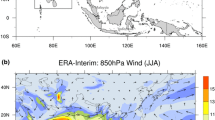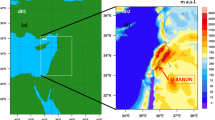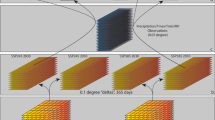Abstract
A set of ten downscaling simulations at high spatial resolution (3 km horizontally) were performed using the Weather Research and Forecasting (WRF) model to generate future climate projections of annual and seasonal temperature and precipitation changes over the Eastern Mediterranean (with a focus on Lebanon). The model was driven with the High Resolution Atmospheric Model (HiRAM), running over the whole globe at a resolution of 25 km, under the conditions of two Representative Concentration Pathways (RCP) (4.5 and 8.5). Each downscaling simulation spanned one year. Two past years (2003 and 2008), also forced by HiRAM without data assimilation, were simulated to evaluate the model’s ability to capture the cold and wet (2003) and hot and dry (2008) extremes. The downscaled data were in the range of recent observed climatic variability, and therefore corrected for the cold bias of HiRAM. Eight future years were then selected based on an anomaly score that relies on the mean annual temperature and accumulated precipitation to identify the worst year per decade from a water resources perspective. One hot and dry year per decade, from 2011 to 2050, and per scenario was simulated and compared to the historic 2008 reference. The results indicate that hot and dry future extreme years will be exacerbated and the study area might be exposed to a significant decrease in annual precipitation (rain and snow), reaching up to 30% relative to the current extreme conditions.














Similar content being viewed by others
Notes
RCP 4.5 reflects a stabilization scenario where total radiative forcing plateaus before 2100 by the utilization of a variety of technologies and strategies for reducing GHG emissions (Clarke et al. 2007). As for RCP 8.5, it is characterized by increasing GHG emissions over time, leading to high GHG concentrations (IPCC 2013).
References
Akadan AR (2008). Climatic changes in Lebanon, predicting uncertain precipitation events—do climatic cycles exist? In Climatic changes and water resources in the Middle East and North Africa. (Eds) Zereini F, Hötz H. doi:10.1007/978-3-540-85047-2_6.
Antic S, Laprise R, Denis B, de Elia R (2004) Testing the downscaling ability of a one-way nested regional climate model in regions of complex topography. Clim Dyn 23:473–493. doi:10.1007/s00382-004-0438-5
Atlas Climatique du Liban (1977) Beyrouth: Republique libanaise Ministere des travaux publics et des transports, Direction de l’aviation civile
Bangalath HK, Stenchikov G (2015) Role of dust direct radiative effect on the tropical rain belt over Middle East and North Africa: a high-resolution AGCM study. J Geophy Res Atmos 120:4564–4584. doi:10.1002/2015JD023122
Barrera-Escoda A, Gonçalves M, Guerreiro D, Cunillera J, Baldasano JM (2014) Projections of temperature and precipitation extremes in the North Western Mediterranean basin by dynamical downscaling of climate scenarios at high resolution (1971–2050). Clim Change 122:567–582. doi:10.1007/s10584-013-1027-6
Bou-Zeid E, El-Fadel M (2002) Climate change and water resources in the Middle East: a vulnerability and adaptation assessment ASCE. J Water Res Plan Manag 128(5):343–355. doi:10.1061/(ASCE)0733-9496(2002)128:5(343)
Brown SJ, Caeser J, Ferro CAT (2008) Global changes in extreme daily temperature since 1950. J Geophy Res 113:D05115. doi:10.1029/2006JD008091
Bukovsky MS, Karoly DJ (2009) Precipitation simulations using WRF as a nested regional climate model. J Appl Meteorol Climatol 48(10):2152–2159. doi:10.1175/2009JAMC2186.1
Caldwell P, Chin HNS, Bader DC, Bala G (2009) Evaluation of a WRF dynamical downscaling simulation over California. Clim Change 95(3–4):499–521. doi:10.1007/s10584-009-9583-5
Cardoso RM, Soares PMM, Miranda PMA, Belo-Pereira M (2012) WRF high resolution simulation of Iberian mean and extreme precipitation climate. Int J Climatol 33(11):2591–2608. doi:10.1002/joc.3616
Chen F, Dudhia J (2001) Coupling an advanced land-surface hydrology model with the PennState NCAR MM5 modeling system. Part I: model description and implementation. Mon Weather Rev 129:569–585. http://journals.ametsoc.org/doi/abs/10.1175/1520-0493%282001%29129%3C0569%3ACAALSH%3E2.0.CO%3B2
Chen J, Lin S (2011) The remarkable predictability of inter-annual variability of Atlantic hurricanes during the past decade. Geophy Res Lett 38(11):L11804. doi: 10.1029/2011GL047629/abstract
Christetin JH, Christenin OB (2007) A summary of the PRUDENCE model projections of changes in European climate by the end of this century. Clim Change 81:7–30. doi:10.1007/s10584-006-9210-7
Christidis N, Stott PA, Brown S, Hegerl GC, Cesars J (2005) Detection of changes in temperature extremes during the second half of the 20th century. Geophy Res Lett 32: L20716. doi:10.1029/2005GL023885.
Clarke L, Edmonds J, Jacoby H, Pitcher H, Reilly J, Richels R (2007) Scenarios of greenhouse gas emissions and atmospheric concentrations. Sub-report 2.1 A of Synthesis and assessment product 2.1 by the U.S. climate change science program and the subcommittee on global change research. Department of Energy, Office of Biological & Environmental Research, Washington, 7 DC., USA, pp 154. http://science.energy.gov/~/media/ber/pdf/Sap_2_1a_final_all.pdf
Collins W, Bellouin N, Woodward S et al (2011) Development and evaluation of an Earth-System model-HadGEM2. Geosci Model Dev 4(4):1051–1075. doi:10.5194/gmd-4-1051-2011
Delworth TL, Broccoli AJ, Rosati A, Stouffer RJ et al (2006) GFDL’s CM2 global coupled climate models. Part I: formulation and simulation characteristics. J Clim 19(5):643–669, 672–674. http://journals.ametsoc.org/doi/abs/10.1175/JCLI3629.1
Diaz-Nieto J, Wilby RL (2005) A comparison of statistical downscaling and climate change factor methods: impacts on low flows in the River Thames, United Kingdom. Clim Change 69:245–268. doi:10.1007/s10584-005-1157-6
Donner LJ, Wyman BL, Hemler RS, Horowitz LW, Ming Y, Zhao M, Golaz JC, Ginoux P, Lin SJ, Schwarzkopf MD, Austin J, Alaka G, Cooke WF, Delworth TL, Freidenreich SM, Gordon CT, Griffies SM, Held IM, Hurlin WJ, Klein SA, Knutson TR, Langenhorst AR, Lee HC, Lin Y, Magi BI, Malyshev SL, Milly PCD, Naik V, Nath MJ, Pincus R, Ploshay JJ, Ramaswamy V, Seman CJ, Shevliakova E, Sirutis JJ, Stern WF, Stouffer RJ, Wilson RJ, Winton M, Wittenberg AT, Zeng F (2011) The dynamical core, physical parameterizations, and basic simulation characteristics of the atmospheric component AM3 of the GFDL global coupled model CM3. J Climate 24(13):3484–3519. doi:10.1175/2011JCLI3955.1
Dudhia J (1989) Numerical study of convection observed during the winter monsoon experiment using a mesoscale two-dimensional model. J Atmos Sci 46:3077–3107. doi:10.1175/1520-0469(1989)046<3077:NSOCOD>2.0.CO;2
El-Samra R (2016) High resolution dynamical downscaling to assess the impacts of climate change in regions of complex topography. PhD Dissertation, American University of Beirut, Lebanon
Evans J, McGregor J, McGuffie K (2012) Chap. 9—future regional climates. In: Henderson-Sellers Ann, McGuffie Kendal (eds) The future of the world’s climate (second edition). Elsevier, Boston, pp 223–250. doi:10.1016/B978-0-12-386917-3.00009-9
Flaounas E, Drobinski P, Bastin S (2013a) Dynamical downscaling of IPSL-CM5 CMIP5 historical simulations over the Mediterranean: benefits on the representation of regional surface winds and cyclogenesis. Climate Dyn 40(9–10):2497–2513. doi:10.1007/s00382-012-1606-7
Flaounas E, Drobinski P, Vrac M, Bastin S, Lebeaupin-Brossier C, Stéfanon M, Borga M, Calvet JC (2013b) Precipitation and temperature space-time variability and extremes in the Mediterranean region: Evaluation of dynamical and statistical downscaling methods. Clim Dyn 40(11–12):2687–2705. doi:10.1007/s00382-012-1558-y
Fowler HJ, Blenkinsop S, Tebaldi C (2007) Linking climate change modelling to impacts studies: recent advances in downscaling techniques for hydrological modeling. Int J Climatol 27:1547–1578. doi:10.1002/joc.1556
Friedl MA, McIver DK, Zhang XY, Hodges JCF, Schnieder A, Bacinni A, Liu W (2001) Global land cover classification results from MODIS. In Geoscience and Remote Sensing Symposium, 2001. IGARSS’01. IEEE 2001 International (Vol. 2), 733–735. doi:10.1109/IGARSS.2001.976618
Gall JS, Ginis I, Lin SJ, Marchok TP, Chen JH (2011) Experimental tropical cyclone prediction using the GFDL 25-km-resolution global atmospheric model. Weather Forecast 26(6):1008–1019. doi:10.1175/WAF-D-10-05015.1.
Gao Y, Fu JS, Drake JB, Liu Y, Lamarque JF (2012) Projected changes of extreme weather events in the eastern United States based on a high-resolution climate modelling system. Environ Res Lett 7(4):044025. doi:10.1088/1748-9326/7/4/044025
Gent PR, Danabasoqlu G, Donner LJ, Holland MM, Hunke EC et al (2011) The community climate system model version 4. J Clim 24:4973–4991. doi:10.1175/2011JCLI4083.1
Giorgi F, Mearns LO (1991) Approaches to the simulation of regional climate change: a review. Rev Geophys 29(2):191–216. doi:10.1029/90RG02636
Hadjinicolaou P, Giannakopoulos C, Zerefos C, Lange MA, Pashiardis S, Lelieveld J (2011) Mid-21st century climate and weather extremes in Cyprus as projected by six regional climate models. Reg Environ Change 11:441–457. doi:10.1007/s10113-010-0153-1
Heikkila U, Sandvik A, Sorteberg A (2011) Dynamical downscaling of ERA-40 in complex terrain using the WRF regional climate model. Clim Dyn 37(7–8):1551–1564. doi:10.1007/s00382-010-0928-6
Hong SY, Lim JOJ (2006) The WRF single-moment 6-class microphysics scheme (WSM6). J Korean Meteorol Soc 42(2):129–151. http://box.mmm.ucar.edu/wrf/users/docs/WSM6-hong_and_lim_JKMS.pdf. Accessed 11 Dec 2015
Intergovernmental Panel on Climate Change (IPCC) (2013) In: Stocker TF, Qin D, Plattner GK, Tignor M, Allen SK, Boschung J, Nauels A, Xia Y, Bex V Midgley PM (eds), Climate change 2013. The Physical Science Basis. Contribution of Working Group I to the Fifth Assessment Report of the Intergovernmental Panel on Climate Change. Cambridge University Press, Cambridge. http://www.ipcc.ch/report/ar5/wg1/
Janjic ZI (2001) Nonsingular implementation of the Mellor-Yamada level 2.5 scheme in the NCEP Meso model, Off. Note 437, 61 pp., National Centre for Environmental Protection, Boulder, Colorado. http://www.lib.ncep.noaa.gov/ncepofficenotes/files/on437.pdf. Accessed 14 Oct 2014
Jiang X, Waliser DE, Kim D, Zhao M, Sperber KR, Stern WF, Schubert SD, Zhang GJ, Wang W, Khairoutdinov M, Neale RB, Lee M (2012) Simulation of the intraseasonal variability over the eastern Pacific ITCZ in climate models. Clim Dyn 39(3):617–636. doi:10.1007/s00382-011-1098-x
Laprise R (2008) Regional climate modelling. J Comput Phys 227(7):3641–3666. doi:10.1016/j.jcp.2006.10.024
Lebeaupin Brossier C, Béranger K, Deltel C, Drobinski P (2011) The Mediterranean response to different space–time resolution atmospheric forcings using perpetual mode sensitivity simulations. Ocean Model 36(1–2):1–25. doi:10.1016/j.ocemod.2010.10.008
Lelieveld J, Hadjinicolaou P, Kostopoulou E, Giannakopoulos C, Pozzer A, Tanarhte M, Tyrlis E (2014) Model projected heat extremes and air pollution in the eastern Mediterranean and Middle East in the twenty-first century. Reg Environ Change 14:1937–1949. doi:10.1007/s10113-013-0444-4
Leung LR, Qian Y (2003) The sensitivity of precipitation and snowpack simulations to model resolution via nesting in regions of complex terrain. J Hydrometeorol 4:1025–1043. http://journals.ametsoc.org/doi/abs/10.1175/1525-7541(2003)004%3C1025%3ATSOPAS%3E2.0.CO%3B2
Li D, Bou-Zeid E, Baeck ML, Jessup S, Smith JA (2013) Modeling land surface processes and heavy rainfall in urban environments: Sensitivity to urban surface representations. J Hydrometeorol 14(4):1098–1118. doi:10.1175/JMH-D-12-0154.1
Lo JCF, Yang ZL, Pielke RA Sr (2008) Assessment of three dynamical climate downscaling methods using the weather research and forecasting (WRF) model. J Geophy Res Atmos 113(9):D09112. doi:10.1029/2007JD009216
Martin GM, Bellouin N, Derbyshire S et al (2011) The HadGEM2 family of Met Office Unified Model climate configurations. Geosci Model Dev 4:723–757. doi:10.5194/gmd-4-723-2011
Mellor GL, Yamada T (1974) A hierarchy of turbulence closure models for planetary boundary layers. J Atmos Sci 31:1791–1806. doi:10.1175/1520-0469(1974)031<1791:AHOTCM>2.0.CO;2
Mlawer EJ, Taubman SJ, Brown PD, Iacono MJ, Clough SA (1997) Radiative transfer for inhomogeneous atmosphere: RRTM, a validated correlated-k model for the longwave. J Geophys Res 102:16663–16682. doi:10.1029/97JD00237
O’Gorman PA (2015) Precipitation extremes under climate change. Curr Clim Change Rep 1:49–59. doi:10.1007/s40641-015-0009-3
Persson G, Bärring L, Kjellström E, Strandberg G, Rummukainen M (2007) Climate indices for vulnerability assessments. Swedish Meteorological and Hydrological Institute Meteorology and Climatology Rep. (RMK) 111, pp 80. http://www.smhi.se/polopoly_fs/1.805!Climate%20indices%20for%20vulnerability%20assessments.pdf
Qian Y, Ghan SJ, Leung LR (2010) Downscaling hydroclimatic changes over the western US based on CAM subgrid scheme and WRF regional climate simulations. Int J Climatol 30(5):675–693. doi:10.1002/joc.1928
Ramamurthy P, Li D, Bou-Zeid E (2015) High-resolution simulation of heatwave events in New York City. Theor Appl Climatol. doi:10.1007/s00704-015-1703-8.
Salathé E Jr, Steed R, Mass CF, Wilby PH (2008) A high-resolution climate model for the U.S. pacific northwest: mesoscale feedbacks and local responses to climate change. J Clim 21:5708–5726. doi:10.1175/2008JCLI2090.1
Seneviratne SI, Donat M, Mueller B, Alexander LV (2014) No pause in the increase of hot temperature extremes. Nature Clim Change 4:161–163. doi:10.1038/nclimate2145
Skamarock WC, Klemp JB, Dudhia J, Gill DO, Barker DM, Duda MG, Huang XY, Wang W, Powers JG (2008) A description of the Advanced Research WRF version 3, NCAR Tech. Note, NCAR/TN-475 + STR, pp 125, National Centre for Atmospheric Research, Boulder, Colorado. doi:10.5065/D6DZ069T
Soares PMM, Cardoso RM, Miranda PMA, de Medeiros J, Belo-Pereira M, Espirito-Santo F (2012) WRF high-resolution dynamical downscaling of ERA-interim for Portugal. Clim Dyn 39(9–10):2497–2522. doi:10.1007/s00382-012-1315-2
Sun Y, Solomon S, Dai A, Portmann RW (2007) How often will it rain? J Clim 20:4801–4818. doi:10.1175/JCLI4263.1
Talbot C, Bou-Zeid E, Smith J (2012) Nested mesoscale large-eddy simulations with WRF: performance in real test cases. J Hydrometeorol 13(5):1421–1441. doi:10.1175/JHM-D-11-048.1
Taylor KE, Stouffer RJ, Meehl GA (2012) An overview of CMIP5 and the experiment design. Bull Am Meteorol Soc 93:485–498. doi:10.1175/BAMS-D-11-00094.1
Volodin EM, Dianskii NA, Gusev AV (2010) Simulating present-day climate with the INMCM4.0 coupled model of the atmospheric and oceanic general circulations. Izv Atmos Ocean Phy 46:414–431. doi:10.1134/S000143381004002X
Wang Y, Leung LR, McGregor JL, Lee D, Wang WC, Ding Y, Kimura F (2004) Regional climate modeling: progress, challenges, and prospects. J Meteorol Soc Jpn 82(6):1599–1628. doi:10.2151/jmsj.82.1599
Warrach-Sagi K, Schwitalla T, Wulfmeyer V, Bauer H (2013) Evaluation of a climate simulation in Europe based on the WRF-NOAH model system: precipitation in Germany. Clim Dyn 41(3–4):755–774. doi:10.1007/s00382-013-1727-7
Wilby RL, Wigley TML, Conway D, Jones PD, Hewitson BC, Main J, Wilks DS (1998) Statistical downscaling of general circulation model output: a comparison of methods. Water Resour Res 34(11):2995–3008. doi:10.1029/98WR02577
Yukimoto S, Yoshimura H, Hosaka M et al. (2011) Meteorological research institute-earth system model v1 (MRI-ESM1)—model description. Technical Report of MRI. Ibaraki, Japan, pp 88. http://www.mri-jma.go.jp/Publish/Technical/DATA/VOL_64/tec_rep_mri_64.pdf
Zhang Y, Dulière V, Mote PW, Salathé EP (2009) Evaluation of WRF and HadRM mesoscale climate simulations over the U.S. Pacific Northwest. J Clim 22(20):5511–5526. doi:10.1175/2009JCLI2875.1
Zhao M, Held IM (2010) An analysis of the effect of global warming on the intensity of Atlantic hurricanes using a GCM with statistical refinement. J Clim 23(23):6382–6393. doi:10.1175/2010JCLI3837.1
Zhao M, Held IM, Lin SJ, Vecchi GA (2009) Simulations of global hurricane climatology, interannual variability, and response to global warming using a 50 km resolution GCM. J Clim 22:6653–6678. 10.1175/2009JCLI3049.1
Zhao M, Held IM, Vecchi GA (2010) Retrospective forecasts of the hurricane season using a global atmospheric model assuming persistence of SST anomalies. Mon Weather Rev 138:3858–3868. doi:10.1175/2010MWR3366.1
Acknowledgements
This study was funded by the United States Agency for International Development through the USAID-NSF PEER initiative (Grant#–AID-OAA-A_I1_00012) in conjunction with support from the US National Science Foundation (Grant #CBET-1058027). EBZ was also supported by the US National Science Foundation’s Sustainability Research Network Cooperative Agreement 1444758. NCAR provided supercomputing resources through project P36861020. The research conducted by the KAUST team was supported by the King Abdullah University of Science and Technology. For computer time, HIRAM simulations used the resources of the Supercomputing Laboratory at KAUST in Thuwal, Saudi Arabia.
Author information
Authors and Affiliations
Corresponding author
Rights and permissions
About this article
Cite this article
El-Samra, R., Bou-Zeid, E., Bangalath, H.K. et al. Future intensification of hydro-meteorological extremes: downscaling using the weather research and forecasting model. Clim Dyn 49, 3765–3785 (2017). https://doi.org/10.1007/s00382-017-3542-z
Received:
Accepted:
Published:
Issue Date:
DOI: https://doi.org/10.1007/s00382-017-3542-z




